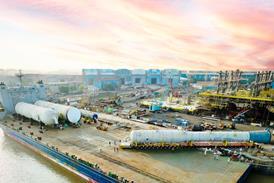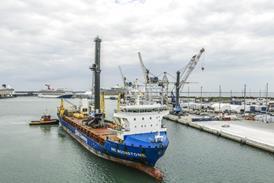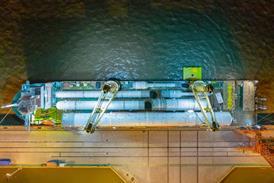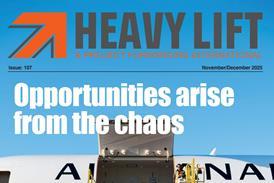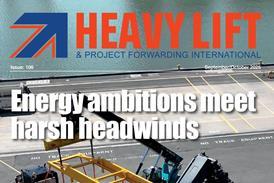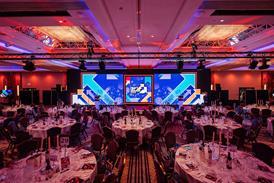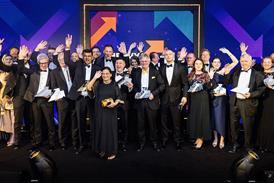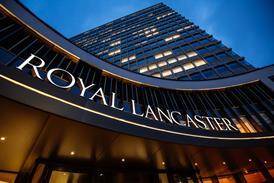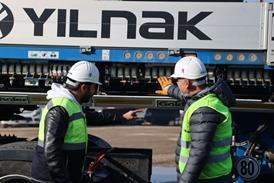Wind energy cargoes have been arriving at the port of Neom in Saudi Arabia in support of renewable energy developments at the Oxagon industrial city. With support from international project logistics specialists Blue Water Shipping and Kuehne+Nagel (K+N), the port has developed its in-house capabilities, training and infrastructure.
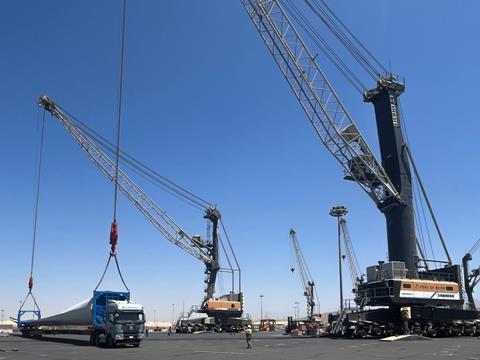
Wind energy cargoes moving through the port are closely tied to the Neom Green Hydrogen Company (NGHC) and its green hydrogen plant that is situated in Oxagon’s industrial quarter. The plant will be entirely powered by renewable energy – in the form of a solar park and wind farm that will feature more than 250 wind turbines.
According to Oxagon, with extensive laydown areas and ample space for manoeuvring, the port of Neom has demonstrated its ability to handle the safe unloading and storage of blades, hubs and tower sections. The layout of the facility enables swift transitions between quayside and yard operations, where mobile harbour cranes (MHCs) are being deployed for yard-side tandem lifts.
Yard operations relating to the wind energy cargoes are managed in-house at the port of Neom. Ivo Minchev, commercial manager of general cargo at the port, said: “This was a strategic move. We wanted to build our own capabilities, reduce third-party dependencies and provide greater flexibility to our customers. We trained our people, acquired the necessary tools, and partnered with the best in the industry to ensure a seamless transition.”
This was the result of a collaboration with Blue Water Shipping, which was engaged to review operational procedures, safety standards, lifting protocols and to assess the readiness of the team to carry out wind turbine generator yard operations.
As part of its role, four experienced stevedores from Blue Water travelled to the port to deliver a two-week training programme for 24 staff, starting with classroom instruction followed by operational training. The training covered all key aspects of wind logistics, including correct lifting, safety procedures, storage area coordination and layout optimisation.
Training progressed from basic vertical lifting to more complex handling procedures, using advanced turbine technology applications project (ATTRAP) components to simulate full-scale turbine operations. Teams executed complete blade lifts with accurate placement using coordinated radio signals and honed their tandem crane skills through repeated drills. The crews also gained experience in stacking containers with twist locks, boosting efficiency across the yard.
“As we began developing this training project, our goal was to have the highest standards of service in port operations, both internally and externally. To achieve this, we sought to collaborate with industry leaders in the wind turbine generator port sector. Blue Water quickly emerged as the clear choice,” said Luis Felipe, senior manager, general cargo at the port of Neom. “The technical team was present on site, providing both assessments and advisory support before and during live operations.”
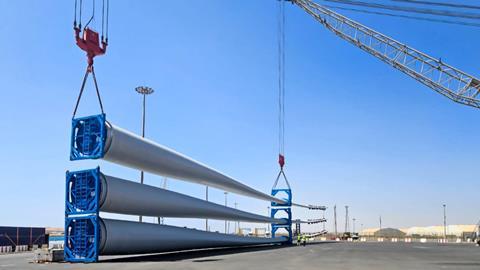
Jacob Sund Thomsen, manager projects at Blue Water, added: “The structured training sessions were met with high engagement, and we quickly saw noticeable progress. The team’s dedication and capacity to absorb complex procedures gave us confidence in their ability to build competence rapidly.”
Safety was a key focus throughout the programme, with handbooks provided on rigging protocols, signal communication and hazard awareness shared with all participants. “Wind turbine generator yard operations are highly technical and logistically demanding due to the size, weight and sensitivity of the components involved,” added Sund Thomsen. “Blades, nacelles, hubs and tower sections require exact handling to prevent damage and ensure personnel safety. Even minor lapses – such as unclear communication or delays – can cause significant risk. Therefore, success depends on planning, discipline, and experience.”
As a result of the programme, 20 full-time team members were certified as Rigger 2, and four additional staff qualified as appointed persons (those who evaluate lift plans and method statements). All employees involved in wind turbine generator operations received technical training refreshers, and every crane operator was trained on both Liebherr’s Sycratronic tandem lift system and manual tandem procedures.
Meanwhile, as the contracted freight forwarder, K+N coordinated the ocean and landside logistics of turbine components from origin to the installation site in Saudi Arabia.
For this, the company had to contend with road infrastructure that was often still under development as well as regional supply chain disruptions. Waleed Agiba, project control tower manager at K+N, explained: “We worked with more than 100 logistics professionals, vessel chartering experts, transport engineers and riggers… The handling teams at port of Neom demonstrated high technical expertise.”
To date, more than 200 turbine components have been handled at the port of Neom. With further shipments due to arrive, and its in-house operations now firmly established, the port plans to deepen its capabilities for complex wind cargo handling.

